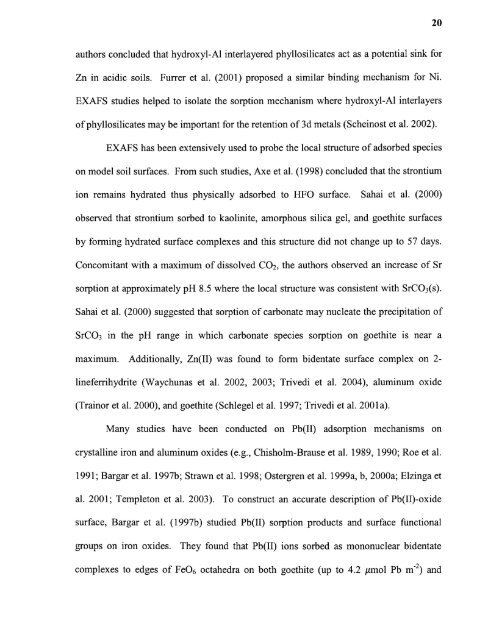Heavy metal adsorption on iron oxide and iron oxide-coated silica ...
Heavy metal adsorption on iron oxide and iron oxide-coated silica ...
Heavy metal adsorption on iron oxide and iron oxide-coated silica ...
You also want an ePaper? Increase the reach of your titles
YUMPU automatically turns print PDFs into web optimized ePapers that Google loves.
20authors c<strong>on</strong>cluded that hydroxyl-Al interlayered phyllo<strong>silica</strong>tes act as a potential sink forZn in acidic soils. Furrer et al. (2001) proposed a similar binding mechanism for Ni.EXAFS studies helped to isolate the sorpti<strong>on</strong> mechanism where hydroxyl-Al interlayersof phyllo<strong>silica</strong>tes may be important for the retenti<strong>on</strong> of 3d <str<strong>on</strong>g>metal</str<strong>on</strong>g>s (Scheinost et al. 2002).EXAFS has been extensively used to probe the local structure of adsorbed species<strong>on</strong> model soil surfaces. From such studies, Axe et al. (1998) c<strong>on</strong>cluded that the str<strong>on</strong>tiumi<strong>on</strong> remains hydrated thus physically adsorbed to HFO surface. Sahai et al. (2000)observed that str<strong>on</strong>tium sorbed to kaolinite, amorphous <strong>silica</strong> gel, <strong>and</strong> goethite surfacesby forming hydrated surface complexes <strong>and</strong> this structure did not change up to 57 days.C<strong>on</strong>comitant with a maximum of dissolved CO2, the authors observed an increase of Srsorpti<strong>on</strong> at approximately pH 8.5 where the local structure was c<strong>on</strong>sistent with SrCO3(s).Sahai et al. (2000) suggested that sorpti<strong>on</strong> of carb<strong>on</strong>ate may nucleate the precipitati<strong>on</strong> ofSrCO3 in the pH range in which carb<strong>on</strong>ate species sorpti<strong>on</strong> <strong>on</strong> goethite is near amaximum. Additi<strong>on</strong>ally, Zn(II) was found to form bidentate surface complex <strong>on</strong> 2-lineferrihydrite (Waychunas et al. 2002, 2003; Trivedi et al. 2004), aluminum <strong>oxide</strong>(Trainor et al. 2000), <strong>and</strong> goethite (Schlegel et al. 1997; Trivedi et al. 2001a).Many studies have been c<strong>on</strong>ducted <strong>on</strong> Pb(II) <str<strong>on</strong>g>adsorpti<strong>on</strong></str<strong>on</strong>g> mechanisms <strong>on</strong>crystalline ir<strong>on</strong> <strong>and</strong> aluminum <strong>oxide</strong>s (e.g., Chisholm-Brause et al. 1989, 1990; Roe et al.1991; Bargar et al. 1997b; Strawn et al. 1998; Ostergren et al. 1999a, b, 2000a; Elzinga etal. 2001; Templet<strong>on</strong> et al. 2003). To c<strong>on</strong>struct an accurate descripti<strong>on</strong> of Pb(II)-<strong>oxide</strong>surface, Bargar et al. (1997b) studied Pb(II) sorpti<strong>on</strong> products <strong>and</strong> surface functi<strong>on</strong>algroups <strong>on</strong> ir<strong>on</strong> <strong>oxide</strong>s. They found that Pb(II) i<strong>on</strong>s sorbed as m<strong>on</strong><strong>on</strong>uclear bidentatecomplexes to edges of FeO6 octahedra <strong>on</strong> both goethite (up to 4.2 μmol Pb m -2) <strong>and</strong>
















